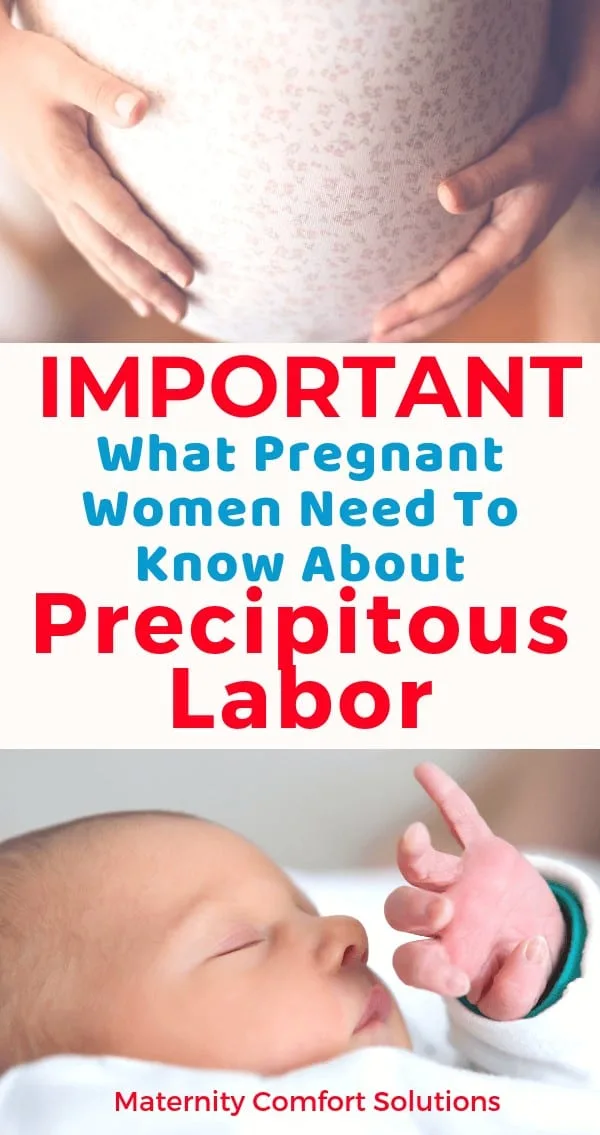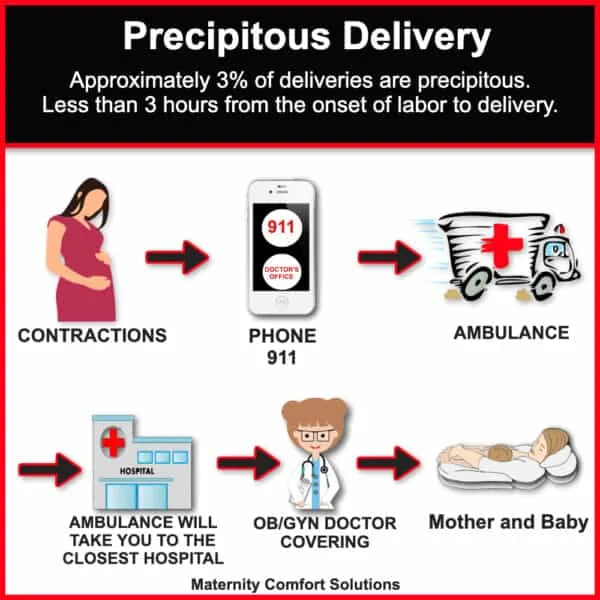Updated October 25, 2023

A fear that is common with many pregnant women is not making it to the hospital in time to deliver their baby. Fear of delivering at home, fear of delivering in the car on the way to the hospital are very real fears, but fortunately, are quite rare. When your labor is moving very fast, it is called precipitous labor.
Precipitous labor is when your baby delivers within 3-5 hours after the onset of regular contractions. This occurs most often among women who have had one or more deliveries. (Source)
What is most remarkable is when a woman has precipitous labor with her first baby. Normal first-time labor can be long (6-20 hours on average), so having the whole process over in under 3 hours might seem desirable.
But rapid labor gives no warning, no time to prepare, and can be terrifying for the parents to be as it is happening.
[wps_quote style=”default” cite=”Doug Penta, MD OB/GYN” url=”https://maternitycomfortsolutions.com”]Yes, there are women who have an uneventful, precipitous delivery of their first child and were glad to have had their delivery in under 3 hours. But such rapid labor and delivery are not without possible complications for both the mother and baby. [/wps_quote]

This post contains affiliate links. If you make a purchase, we may be paid. You can read our full affiliate disclosure at the bottom of this post.
For other women, the rapid onset and intensity of labor and delivery are deeply traumatizing. There is no time to process what is happening and that can lead to the woman feeling like she is not in control.
Precipitous labor occurs in approximately 3 % of pregnancies. So it is quite rare.
But as Sue and I often discuss, there is little comfort in statistics if it happens to you.
So we would rather see you prepared for the possibility, no matter how slim.
We hope that if it does happen to you, you will have knowledge of what to expect and will feel more in control of the situation.
[wps_box title=”How To Feel Prepared For Your Labor & Delivery” title_color=”#FFFFFF” box_color=”#dd3939″ radius=”0″]
Are you feeling scared about your upcoming labor and delivery?
Preparation is KEY to letting go of your fears.
The VERY best way to prepare for labor and delivery is to take a childbirth class.
Do you want to feel empowered, confident and fully prepared for childbirth?
Hilary’s Online Prenatal Class is the one for YOU!
Taught by an L&D nurse with 20 years of experience!
You will be FULLY prepared for the big day! [/wps_box]
Let’s jump into what the signs and symptoms can be for precipitous labor. These are the most common, but keep reading because as you’ll soon see they are not always so obvious!
What are the symptoms of precipitous labor?
- Very Sudden onset of strong contractions. You may feel contractions one right after another without any chance to recover in between.
- Pain that is very intense and feels like the contraction never stops.
- A sudden feeling of pelvic pressure and need to push. It may feel like a bowel movement.
[wps_icon icon=”check” background=”#31b522″ color=”#ffffff” size=”20″ padding=”6″ radius=”0″]Your symptoms may not be exactly as described above. You may feel fine and out of nowhere get sudden pain or feel like you need to use the bathroom and find out you are about to deliver your baby.
That scenario is exactly what happened to a relative of mine who was pregnant with twins. Baby A was born within minutes of her feeling pain and going to the bathroom.
Baby A “whooshed out” in their bathroom as her husband called 911 and delivered the baby. First responders arrived transported her and baby A to the hospital where she delivered Baby B within 2 hours of Baby A.
She had no history of precipitous labor and had a c-section scheduled to deliver the twins.
This is why we believe it is important that every pregnant woman knows that precipitous labor is a possibility, even if it is very slim.
Who is at risk for having precipitous labor?
The most significant risk factor for precipitous delivery is a history of having one with a previous pregnancy.
That’s not very helpful if you are going to be a first-time mom though.
Some other factors may play a role in having precipitous labor.
Some of those factors are having:
- Hypertensive complication (preeclampsia)
- A family history of rapid onset of labor and delivery
- Young maternal age
- Lower birth weight infants.
How can I prepare for a precipitous delivery?
I have seen women go through their labor and delivery in less than one hour.
The best advice a healthcare provider can give you is to be emotionally prepared.
Being emotionally prepared can make a tremendous difference in your childbirth experience. Every woman expects what childbirth “should be”.
One of the most popular books about pregnancy and childbirth focuses on expectations for just this reason. Childbirth is not always predictable. Rapid labor can happen, even in a first time mom.
Over the past 10 years, I have seen birth plans become more common. Birth plans are a guide and an ideal birth scenario of all the things you’d like your birth experience to have and to be. But one thing we emphasize about birth plans is to be flexible and realize your entire plan can go out the window in a matter of minutes.
If you have rapid labor and delivery, you will need to default to birth plan B.
[wps_icon icon=”check” background=”#31b522″ color=”#ffffff” size=”20″ padding=”6″ radius=”0″]Normal labor and delivery progress is measured in hours, precipitous delivery is measured in minutes.
Your chances of having a precipitous delivery are slim (unless you have had one before!) so consider this post like a fire drill in school, probably won’t ever happen, but good to be prepared just in case.

Here are a few things that could happen if you have precipitous labor:
1. Your Partner may not be present for your delivery.
In my experience, this happened less than 10% of the time. There were a few times where the delivery went so fast that the partner was not there.
They may have gone to park the car, get your bags, call family members or grab a bite to eat completely unaware that your labor or delivery was taking the express lane.
2. Your provider or a medical colleague from your medical practice may not deliver your baby.
You may be delivered by a doctor or midwife who is at the hospital that you do not know.
Your doctor or midwife may not make it in time for your delivery. The hospital may have a laborist who covers deliveries on the unit and that can be who delivers your baby.
Things will be moving so fast and your contractions and need to push may be so strong that during your delivery, you may not even care.
3. You may not deliver at your planned medical facility.
If your labor is moving so fast that you need to call 911 from home or the road you may not get to go to the hospital you planned to deliver at.
When Emergency Medical Technicians are called, their job is to safely transport you to the closest medical facility.
This may not be the medical facility where you planned on delivering. It is also possible that the first responders may deliver your baby.
First responders have delivered more than one happy, healthy baby on the side of the road. They are trained for all kinds of emergencies.
It is important to know that the EMT’s will do what they feel is in your best interest as they know the transport times and the locations of the closest medical facilities.
4. You may not get the pain medication you planned on receiving.
Deep breath on that one. Your labor and delivery may be moving too fast to medicate you before the delivery.
You may not make it to the hospital in time. If you had planned on having an epidural or other medication there may not be time.
Try to work with medical personnel as they will do the best they can to accommodate your desires while also making sure you and your baby remain safe.
5. You and/or your baby may have some complications from such rapid labor and delivery.
Precipitous labor doesn’t give your body or baby time to prepare for delivery. You and your baby could be in a state of shock and need time to recover.
We talk more about the complications of such a rapid birth below.
Maternal vaginal tearing, an increased risk of postpartum hemorrhage, shoulder dystocia, an increased risk of uterine rupture if you have had a previous c-section, and emotional trauma.
What complications can the mother have?
1. Perineal/vaginal tears:
Even though precipitous deliveries may take up to 3 hours, the majority of this time spans from the first contraction until the cervix is fully dilated.
This means that the mother is progressing through the first stage of labor in 3 hours.
The second stage of labor with a precipitous vaginal delivery is typically a matter of seconds to minutes.
The second stage for normal delivery is most often measured in hours. Often called the “pushing phase” of labor, this is when the fetus is moving down the birth canal until the head is “crowning” immediately before delivery.
This time during the second stage of labor allows the vaginal canal and perineum time to stretch, dramatically reducing trauma to the soft tissues at the moment the fetus is delivered.
Though it is not uncommon for first deliveries to have vaginal tears (up to 95% ACOG), they are often limited when perineal stretching and maneuvers to support the perineum are used.
A delivery occurring in this way is referred to as a “controlled spontaneous vaginal delivery”.
Often, women who have had a prior delivery will have no tears at the time of delivery.
The second phase or pushing phase is shorter but there is still enough time for the perineal tissues to accommodate delivery without tearing.
Many articles have been written that address the ability of the perineum to stretch. Articles about the benefits of perineal massage delayed pushing, super crowning, all to decrease tearing (Source)
2. Postpartum Hemorrhage
The uterus is a large muscle. Like any muscle, it can develop muscle fatigue, especially after the strong and almost unremitting contractions associated with precipitous deliveries.
Once the baby is delivered, the powerful expulsive forces over such a short period result in muscle fatigue.
In most situations where our body experiences muscle fatigue (ie. Marathon), the muscle has time to recover without any adverse consequences.
After a precipitous vaginal delivery, the major concern is that the uterus is not given time to recover after the third phase of labor (expulsion of the placenta).
The uterus must immediately contract to avoid bleeding once the placenta has separated.
When the uterus is unable to contract due to uterine “atony”, postpartum hemorrhage can occur and may require vigorous medical intervention to control.
This bleeding may not occur immediately after delivery. (Source)
3. Shoulder Dystocia
Precipitous delivery is a risk factor for Shoulder Dystocia. (Source)
Shoulder dystocia occurs when the fetal shoulder gets stuck under the pubic bone.
This can result in more extensive vaginal tears as various maneuvers are performed to deliver your baby as quickly and safely as possible.
4. Uterine Rupture
Women who have had a prior cesarean section are at risk for a uterine rupture with precipitous labor. (Source)
The risk of uterine rupture when laboring after a prior cesarean section (VBAC) is well-known.
Given the intensity of contractions associated with a precipitous delivery, it is extremely important to tell emergency healthcare providers if you have had a prior cesarean section.
5. Emotional Trauma
Women who have a precipitous delivery can experience emotional trauma. These women must receive appropriate care by trained professionals. Such rapid labor and birth can cause the woman to have a very traumatic birth experience.
What complications can the baby have?
1. Intracranial hemorrhage
Precipitous labor can be traumatic for the baby. Instead of labor lasting hours, your baby has to course through the bony pelvis rapidly. This does not allow time for your baby’s head to mold to the pelvis. This complication is not common and is most often associated with prematurity.
2. Meconium aspiration
A delivery that is not precipitous is referred to as a “spontaneous, controlled vaginal delivery”. A “controlled” delivery allows time to suction the baby’s mouth once the head is delivered and before your baby takes a breath.
This is particularly important if there is meconium (baby poop) in the amniotic fluid.
If the delivery does not allow time to suction the baby, there is a risk the baby can get meconium-stained fluid in the lungs.
This is not a common complication.
3. Shoulder Dystocia
Shoulder dystocia is a serious complication of precipitous deliveries. When a delivery is rapid, the baby’s shoulder can get stuck under the pubic bone requiring maneuvers to reduce the risk of nerve injury.
The animation below shows how your baby rotates during descent through the birth canal. The front shoulder has to slip under the pubic bone at the time of delivery. Shoulder dystocia occurs when the front shoulder is unable to pass under the pubic bone.
Shoulder dystocia occurs with labors of normal duration as well and is often the result of a large baby. When shoulder dystocia occurs with a precipitous delivery it is often because there is not enough time for the pelvis to go through the adaptive changes to accommodate childbirth.
There are many maneuvers your provider will use to deliver your baby if shoulder dystocia occurs.
Recovery after a precipitous delivery:
The moments after a precipitous delivery are emotionally and physically draining for both mother and infant. Mom has her newborn baby already bundled up beside her as she is still processing what just took place.
Fortunately, the majority of precipitous deliveries do not result in serious physical complications to the mother or infant.
From an emotional standpoint, some mothers do experience significant trauma including postpartum PTSD.
Postpartum recovery after precipitous labor:
Your postpartum recovery will likely be similar to the recovery for normal vaginal delivery. You may feel great, but do not overdo it.
You need to rest and heal. If you suffered complications such as vaginal tearing, your recovery will take longer. Ice packs will become your new best friend!
It is important to let family and friends know that just because you had a super fast labor and delivery, your postpartum recovery takes the same time frame as a normal delivery.
You may need to limit visitors when you first come home. That is OK. If you need time to process what happened to you and if you are still stunned by the rapid course of events, take time for you.
The very last thing you will be interested in hearing is how “lucky” you are that your labor went so quickly.
We have written a helpful and comprehensive guide on postpartum recovery that you will want to read next:
You can the two-part series here.
I suggest you read part two first because these are the 25 essential items you’ll need for your postpartum recovery.
These are the items I used and some additional recovery advice I found worked best after my precipitous labor which ended up in an emergency c-section.
Part one explains all the changes your body will go through and possible complications. So you will want to read that too.




